The best tropical privacy fence plants include clumping bamboo for quick growth, evergreens like Podocarpus and Clusia for year-round screening, and tall palms such as Areca and Fishtail that reach 20-30 feet. For dense barriers, consider Clusia rosea or flowering options like hibiscus and gardenias. You’ll get ideal privacy by creating multi-layered plantings with tall canopy plants, mid-level shrubs, and ground-level foliage. Discover how to combine these tropical beauties for your perfect living fence.
What Are The Best Tropical Privacy Fence Plants?
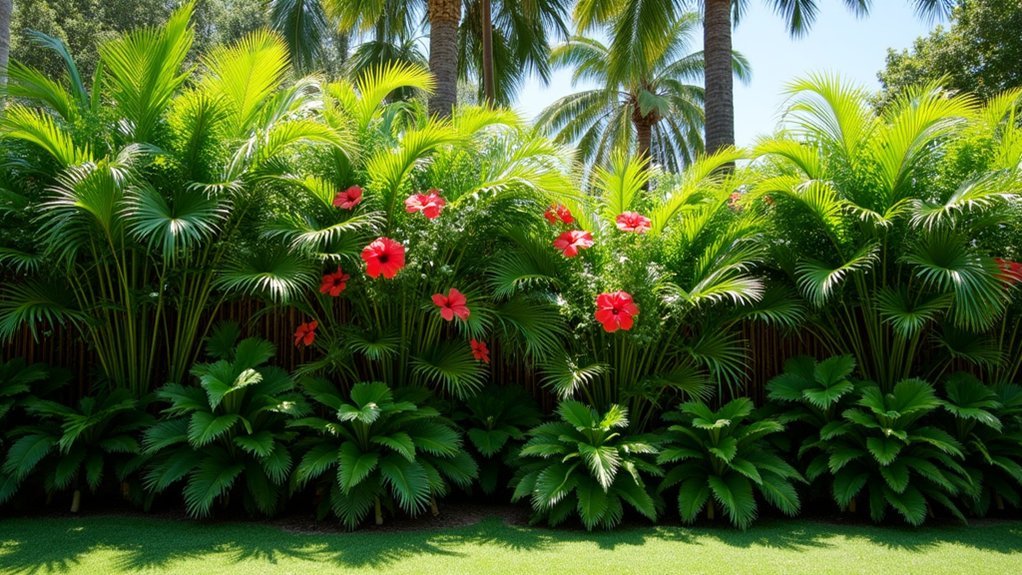
When creating a tropical privacy screen for your yard, several outstanding plant options can transform ordinary boundaries into lush, vibrant sanctuaries.
Bamboo varieties offer quick solutions, with clumping types providing non-invasive coverage and golden bamboo reaching impressive heights of 20-30 feet.
For evergreen options, consider podocarpus with its thick foliage or areca palm with graceful, arching fronds that create dense screens up to 20 feet tall.
Clusia (pitch apple) delivers year-round privacy with leathery leaves that effectively block sightlines.
If you’d prefer colorful alternatives, cassia trees, bougainvillea, and hibiscus add vibrant blooms to your privacy barrier.
Fast-growing hedges like schefflera, ligustrum, and ficus nitida create substantial screens that can be shaped through regular pruning.
The fishtail palm provides exceptional screening with its dense foliage and can grow approximately 3 feet yearly, making it an excellent choice for creating quick privacy.
Selecting the Right Tropical Plants for Your Privacy Needs
Because successful tropical privacy screens depend on appropriate plant selection, you’ll need to take into account several critical factors before making your choices.
Thoughtful plant selection forms the cornerstone of any effective tropical privacy screen.
Consider your local climate conditions, available space, and maintenance capacity before investing in any tropical privacy plants.
When evaluating potential candidates for your natural screen, focus on:
- Growth characteristics – Choose plants with dense foliage like Clusia rosea or Areca Palms for maximum screening, ensuring they’ll reach your desired height.
- Maintenance requirements – Select drought-tolerant species that match your soil conditions and require minimal pruning if you want a low-maintenance solution.
- Aesthetic preferences – Incorporate plants with varying textures, colors, and blooming periods to create visual interest while maintaining privacy year-round. The Giant Bird of Paradise can create impressive visual impact with its towering height of up to 10 meters while providing maximum seclusion.
Tall Palm Varieties for Complete Visual Screening
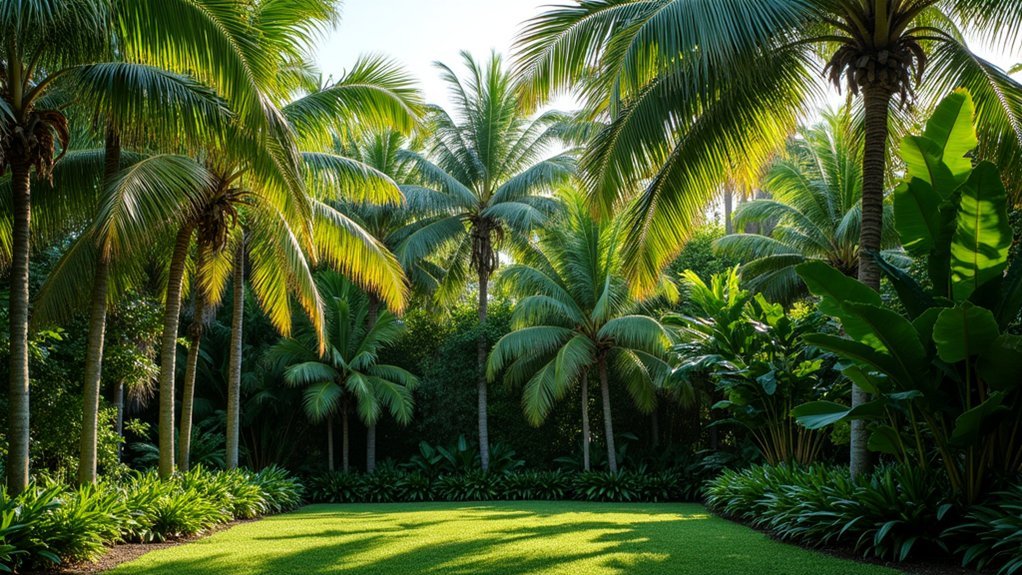
Creating a natural tropical barrier requires selecting palms with sufficient height and density to guarantee complete privacy.
The Areca Palm reaches an impressive 20 feet with fine-textured fronds, making it perfect for landscape backdrops in zones 10A-11. For taller screening, consider the Fishtail Palm, growing 25 feet tall with distinctive bipinnate leaves that attract birds while forming dense barriers when planted 5-6 feet apart.
The Paurotis Palm offers exceptional screening with its fan-shaped fronds reaching 20-30 feet, particularly suited for wet or coastal environments. Native to South America, this palm has established well in Florida and produces attractive white flowers and colorful fruits that enhance its visual appeal.
In understory locations, Ptychosperma schefferi provides mid-height screening with arching fronds, while Pinanga coronata forms compact 10-15 foot clusters ideal for narrower spaces.
All these varieties require minimal maintenance while delivering year-round tropical privacy.
Dense Foliage Hedges That Thrive in Tropical Climates
While palms offer impressive height for privacy screens, dense foliage hedges provide a more compact and visually solid barrier in tropical settings.
Plants with tightly packed leaves create impenetrable screens that also reduce wind impact and noise from neighboring areas.
For the most effective tropical privacy hedges, consider:
- Clusia rosea – With thick, leathery leaves, this moderate-to-fast growing plant tolerates drought once established and forms an exceptionally dense barrier.
- Phaleria Clerodendron – Its erect habit and scented flowers combine beauty with functionality, thriving in hot, humid conditions.
- Calathea lutea – This robust leafy plant quickly fills gaps, resulting in a lush screen that maintains its density year-round.
Regular pruning enhances these hedges’ density and keeps them looking pristine in your tropical landscape. For optimal results, plant these tropical shrubs closer than their mature width to achieve a seamless hedge appearance more quickly.
Colorful Flowering Plants That Double as Privacy Screens
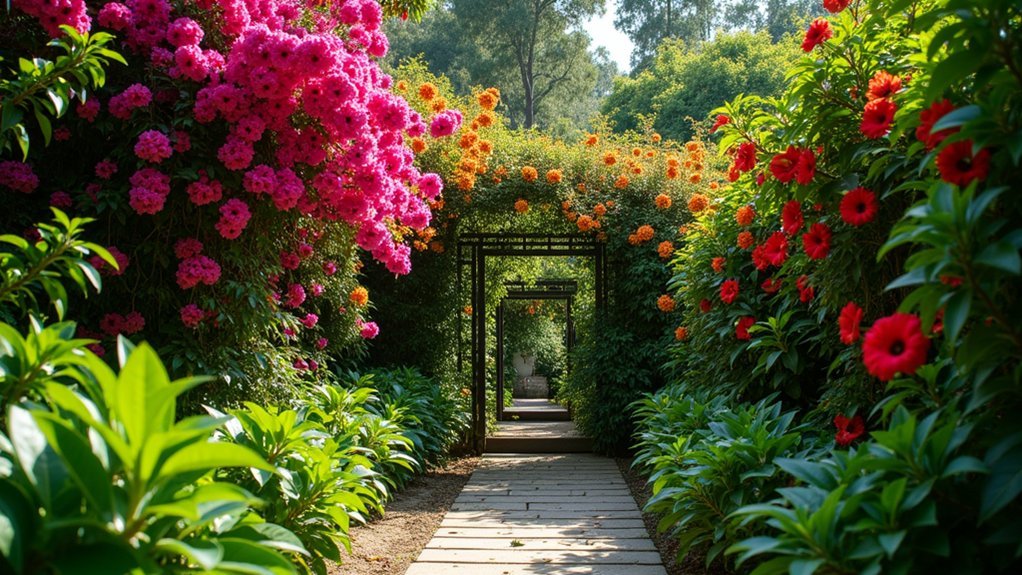
Tropical gardens don’t have to sacrifice beauty for privacy—colorful flowering plants can magnificently serve both purposes.
Gardenias create dense barriers with their fragrant white blooms, while hibiscus clusters form striking screens with their large, colorful flowers.
Fragrant gardenias and vibrant hibiscus transform ordinary boundaries into sensory-rich living walls that delight while they shield.
For pink-hued privacy, consider Camellia japonica, which develops into an elegant hedge when properly maintained.
In truly tropical settings, mandevilla and bougainvillea offer vibrant options—the former with its pink and white blooms, the latter with its dramatic colorful bracts.
Plant these showstoppers in full sun and well-drained soil for best results.
Indian Laurel Fig can be an excellent addition to your tropical privacy screen with its tight, dense foliage that provides exceptional coverage while maintaining a manicured appearance.
Consider mixing varieties to guarantee year-round visual interest, or try lantana and heliconia for drought-tolerance.
Planting in groups enhances density while providing maximum privacy without sacrificing the exotic beauty that makes tropical gardens special.
Fast-Growing Vines for Immediate Fence Coverage
Impatience often drives gardeners toward vines as privacy solutions. In tropical settings, several varieties offer rapid coverage while thriving in heat and humidity. For quick results, consider Mexican Coral Vine which establishes dense screens with vibrant pink flowers, or Trumpet Vine that can climb 30-40 feet with lush foliage. Trumpet Vine’s trumpet-shaped flowers are excellent for attracting hummingbirds to your privacy screen.
For ideal privacy fence coverage, focus on:
- Confederate Jasmine for evergreen, low-maintenance screening with fragrant white blooms
- Passion Fruit Vine when you want both privacy and edible harvests from your boundary
- Virginia Creeper for its adaptability, minimal care requirements, and spectacular fall color change
Most tropical vines require only occasional pruning to maintain shape while continuing to provide the dense coverage you’re seeking.
Bamboo Species for Natural Tropical Barriers
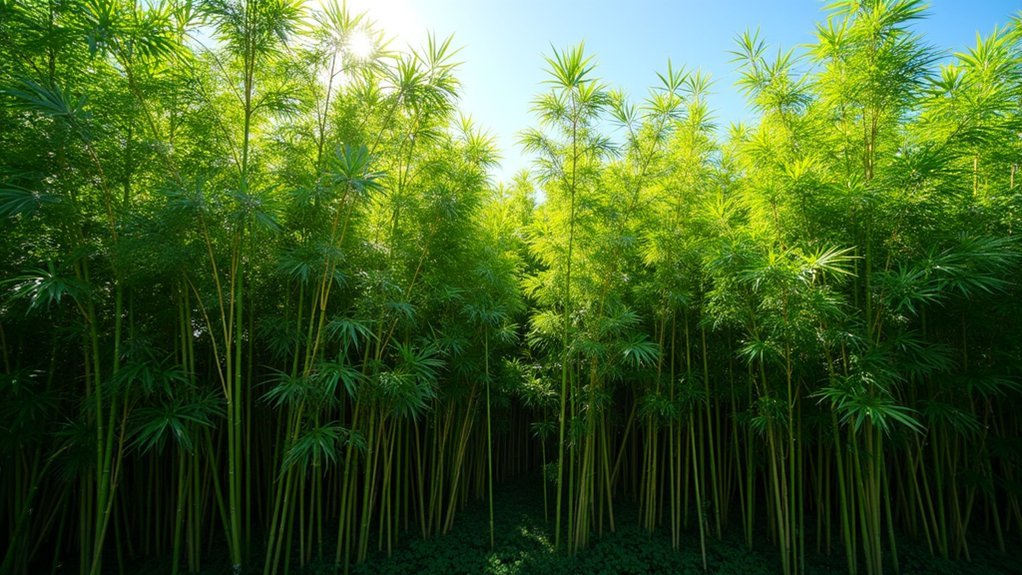
Bamboo stands as one of the most impressive natural options for creating privacy barriers in tropical landscapes. You’ll find both running and clumping varieties suitable for privacy screens, with running bamboo establishing quickly but requiring containment strategies to prevent invasive spread.
For tropical environments, consider species that thrive in both humid and dry conditions. Bambusa boniopsis, growing to 25 feet tall with a minimum temperature tolerance of 27°F, offers a delicate appearance perfect for privacy screening. You’ll appreciate bamboo’s remarkable adaptability to various soil types and temperature fluctuations. Most varieties offer excellent drought resilience while providing both visual appeal and noise buffering benefits.
To manage bamboo effectively, install physical barriers to control running varieties or choose clumping bamboo for easier maintenance. The dense growth creates not only privacy but also acts as a wind buffer.
For colder tropical regions, select cold-tolerant running bamboo species for year-round screening.
Combining Plants for Multi-Layered Privacy Solutions
For complete tropical privacy, you’ll need to create a multi-dimensional barrier by combining tall feature trees, dense mid-level shrubs, and lush understory plants.
Your layered approach should account for seasonal changes by pairing evergreens like Clusia with flowering plants such as Hibiscus and Oleander that provide visual interest throughout the year.
In humid tropical zones, pack plants more densely with moisture-loving specimens like Monstera and ferns, while in drier coastal areas, space drought-tolerant options like Coconut Palms and Acacia slightly further apart. Consider incorporating palms like Archontophoenix cunninghamiana that can grow up to 40 feet tall, offering both height and dappled shade for your privacy screen.
Layered Vertical Structure Design
Creating a layered vertical structure with tropical plants offers three distinct advantages for your privacy fence: complete coverage from ground to sky, visual depth that’s more appealing than a flat hedge, and ecological diversity that supports wildlife.
Design your privacy screen with these three vertical zones:
- Tall canopy (8-25 feet) – Plant Areca Palms, Clusia, or clumping Bamboo as your backdrop, providing maximum height and the foundation of your privacy screen. Many experienced gardeners report that Pinanga coronata establishes quickly and fills in hedge gaps better than other palm varieties.
- Mid-level (4-8 feet) – Fill the middle zone with Hibiscus, White Bird of Paradise, or Gardenia tubifera to create density and block sightlines at eye level.
- Understory (ground level) – Add Monstera, Philodendron, or ferns to fill gaps between taller plants and soften the base of your living fence.
Seasonal Planting Combinations
With your layered vertical structure in place, the next step is selecting seasonal planting combinations that work together harmoniously throughout the year. Choose plants that provide year-round color like Heliconia Hot Rio Nights, while creating a diverse canopy with Golden Cane Palm and Giant Bird of Paradise. Integrating tropical landscaping elements will enhance the aesthetic appeal and privacy function of your fenceline design.
| Season | Upper Layer | Middle Layer | Base Layer |
|---|---|---|---|
| Spring | Coconut Palm | Brazilian Red Cloak | Monstera deliciosa |
| Summer | Golden Cane Palm | Giant Bird of Paradise | Gardenia tubifera |
| Fall/Winter | Fast-growing palms | Cordylines | Xanadus |
Fill gaps at the base with Monstera or Gardenia tubifera. For visual interest, mix matte and glossy-leaved plants. Consider wind resistance when selecting species—Brazilian Red Cloaks have proven resilient to strong winds, while Heliconia and Alocasias thrive in partial to full sun environments.
Climate-Specific Density Solutions
While tropical regions offer ideal growing conditions for privacy screens, each microclimate demands specific plant combinations to achieve maximum density.
You’ll need to layer plants strategically based on your specific conditions to create impenetrable, sustainable privacy barriers.
For best tropical privacy screens:
- Upper canopy coverage – Install tall feature trees like coconut palms (reaching 30 feet) to block rooflines and provide the structural backbone of your privacy screen.
- Middle-zone density – Plant wind-resistant shrubs like Brazilian Red Cloak (8-12 feet) beneath taller specimens to fill gaps and create continuous screening where bare palm trunks would otherwise create visibility. Consider adding Clusia rosea for its thick, leathery leaves that create an excellent dense barrier up to 25 feet tall.
- Ground-level fullness – Integrate lower-growing plants or flowering shrubs to conceal exposed soil and create a complete floor-to-sky privacy solution that maintains visual interest year-round.
Low-Maintenance Tropical Privacy Options
Tropical privacy plants don’t have to demand constant attention from you to thrive. Several varieties offer excellent screening while requiring minimal upkeep in Florida’s climate.
| Plant | Maintenance Benefits |
|---|---|
| Clusia | Maintains form naturally; resistant to pests and disease |
| Golden Cane Palm | Needs infrequent pruning; tolerates drought conditions |
| Bougainvillea | Requires minimal watering once established; rapid coverage |
| African Iris | Self-cleaning flowers; no deadheading required |
Choose plants like Xanadu Philodendron with its broad, deeply-lobed leaves that deter pests naturally, or the Beach Sunflower that spreads without intervention. Areca Palms repel common insects while providing dense screening. For truly hands-off privacy, consider Oleander, which thrives in dry heat with almost no care while reaching impressive heights of 15-20 feet. Remember to apply hardwood mulch around your tropical privacy plants to conserve moisture and naturally suppress weeds without additional effort.
Salt-Tolerant Privacy Plants for Coastal Properties
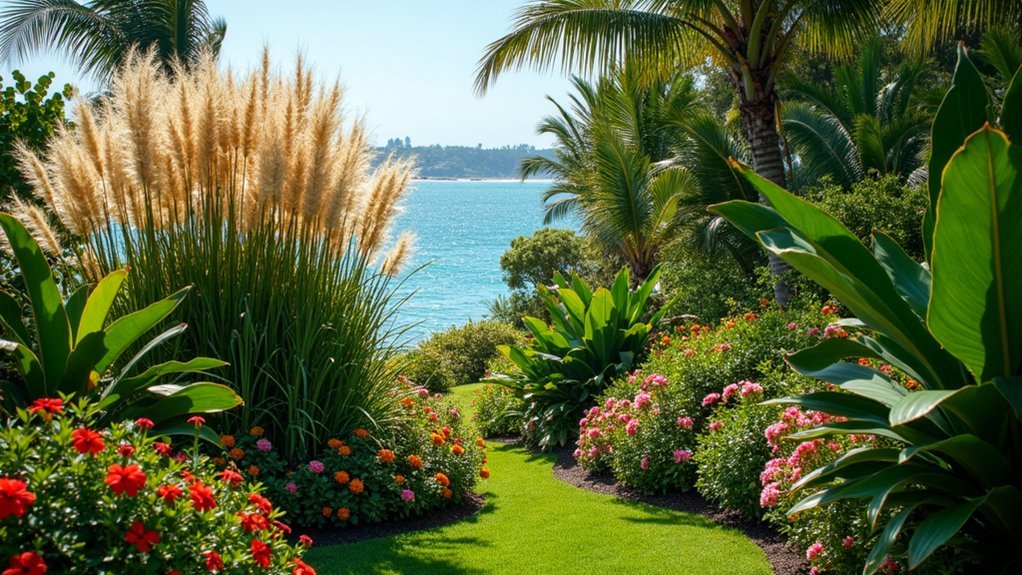
Living near the coast demands special consideration when selecting privacy plants. Salt spray, sandy soils, and strong winds create challenging conditions that require specially adapted species.
Coastal environments challenge gardeners to find privacy solutions that can withstand nature’s saltiest, windiest conditions.
Fortunately, several salt-tolerant options can create effective privacy barriers while thriving in coastal environments.
- Shrubs – Japanese Boxwood and Podocarpus macrophyllus form dense, salt-resistant hedges that maintain their structure even in harsh conditions.
- Grasses – Panicum virgatum (Switch Grass) and Miscanthus species provide movement, texture, and height while handling beachfront conditions with ease. Sea Oats are particularly valuable as they not only offer privacy but also provide excellent erosion control in beach landscapes.
- Trees and Palms – Willow Oak (Quercus phellos) offers native salt tolerance, while Chinese Windmill Palm (Trachycarpus fortunei) provides tropical appeal with excellent salt and drought resistance.
For best results, implement layered landscaping with highly salt-tolerant plants protecting more sensitive species.
Drought-Resistant Privacy Plants for Drier Tropical Areas
Arid tropical regions present unique challenges for privacy landscaping, requiring plants that not only create effective screening but also withstand extended dry periods with minimal water.
Hopseed (Dodonaea viscosa) offers lush evergreen foliage and fast growth, with the ‘Purpurea’ cultivar providing attractive purple-tinted leaves.
Slim Bottlebrush excels in extremely low-water conditions while supporting pollinators with its distinctive red cylindrical flowers.
For rapid privacy, consider Italian Buckthorn, which grows 1-2 feet yearly while improving soil quality.
Golden Bamboo creates a tropical aesthetic in arid settings, though you’ll need to monitor its potentially invasive spread.
For coastal microclimates, California Wax Myrtle thrives with salt spray exposure and serves as an effective windbreak once established.
Tuscan Blue Upright Rosemary provides fragrant screening with its vertical growth habit and offers significant savings compared to similar privacy plants.
Creating Year-Round Privacy With Evergreen Tropicals
When designing a year-round privacy solution in warm climates, evergreen tropical plants offer unmatched reliability and visual appeal.
Plants like Philodendron, Schefflera, and Ficus benjamina provide dense foliage that maintains screening effectiveness throughout all seasons while requiring less maintenance than deciduous alternatives.
For ideal privacy screening results:
- Prepare soil thoroughly to support healthy growth and guarantee proper spacing between plants to create a seamless barrier without excessive pruning needs.
- Select climate-appropriate varieties like Bird of Paradise or Hawaiian Ti Plants that add vibrant colors while maintaining structural integrity.
- Integrate complementary elements such as strategic lighting and curved pathways to enhance both the functionality and aesthetic appeal of your private outdoor sanctuary.
For zones 9-11, the Monterey Bay Brush Cherry creates an impressive natural screen with its full-branching growth habit that can reach heights of up to 20 feet tall.
Space-Saving Narrow Profile Plants for Tight Boundaries
Urban and small-space gardeners face unique challenges when establishing privacy screens. Fortunately, several tropical plant varieties offer dense foliage with remarkably slim profiles, perfect for tight boundaries.
The Golden Cane Palm provides vertical screening while maintaining a slender footprint in bright spots.
For dramatic color in containers or narrow beds, consider Orange Rocket shrubs.
Hopseed Bush delivers excellent privacy with its naturally upright growth pattern when regularly pruned.
Don’t overlook Cordylines with their striking foliage and space-conscious growth habit.
Privets can be trained into compact hedges despite their variable sizing potential.
For ground-level coverage that supports layered privacy solutions, Xanadus offers versatility.
All these options deliver the lush tropical aesthetic you’re seeking without demanding excessive space—ideal when every inch of your garden counts.
Frequently Asked Questions
How Quickly Can I Create Complete Privacy With Tropical Plants?
You can create complete privacy in 1-2 years using pre-grown specimens in staggered rows. Plant bamboo or bougainvillea for quickest results, especially during Florida’s wet season with proper spacing and maintenance.
Which Tropical Privacy Plants Are Pet and Child-Friendly?
For your pet and child-friendly tropical privacy needs, consider ponytail palms, hibiscus trees, Boston ferns, windmill palms, and money trees. They’re all non-toxic while providing dense growth for effective screening in tropical conditions.
How Do I Prevent Tropical Privacy Plants From Invading Neighbors’ Property?
Plant clumping bamboo varieties instead of runners. Install root barriers 24-30 inches deep. Choose slow-growing, non-rhizomatous plants. Keep adequate distance from property lines and maintain regular pruning to control spread. Monitor boundaries frequently.
Can Tropical Privacy Plants Damage Underground Utilities or Foundations?
Yes, they can damage utilities and foundations. Choose species with non-invasive roots, plant them away from structures, install root barriers, and maintain regular pruning. Clumping bamboo is safer than running varieties.
How Do Tropical Privacy Plants Fare During Hurricane Season?
During hurricane season, you’ll want wind-resistant tropical privacy plants with deep roots like Sabal palms or live oaks. They’ll recover faster after storms, while weak species like Chinese elms may be completely destroyed.
In Summary
You’ve got plenty of tropical privacy options for your unique needs! Whether you’ll benefit from tall palms, dense hedges, colorful flowering species, salt-tolerant varieties, drought-resistant plants, evergreen tropicals, or narrow-profile options, the perfect living barrier awaits. Consider your climate, space, and maintenance preferences when making your selection, and you’ll soon enjoy a beautiful, natural screen that enhances your outdoor sanctuary.

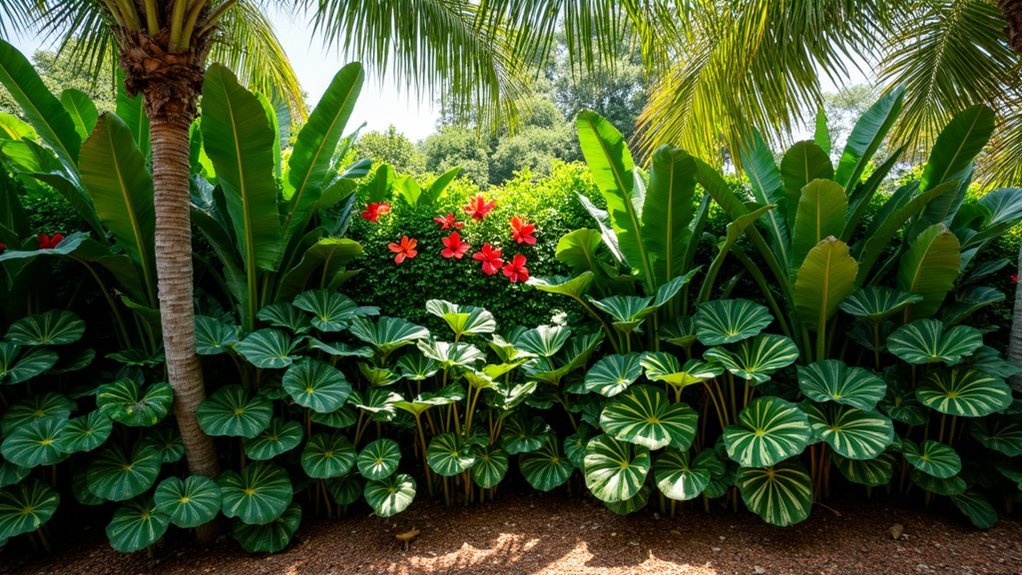



Leave a Reply